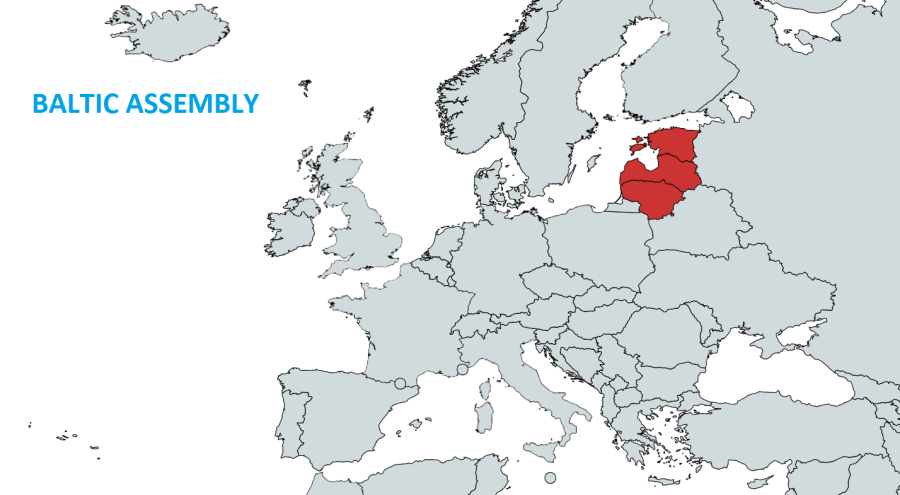When it comes to actual cross border policies, all regions, and countries involved, no matter their geographical position, cultural and historical context are faced with the same question: “What would be the most effective structure of cooperation to plan, design and implement cross border interventions and policy?”. The answer that each cross-border area gives to this question will greatly influence their ability to overcome obstacles such as administrative or legal ones in order to make sure that the envisioned goals and targets are reached. In this article, we showcase how governmental and parliamentary cooperation has significantly contributed to a series of issues of cross border regions and whole nations! The Baltic Assembly is one of the more recent examples of this in the history of Europe and one that other regions and countries in Europe could follow.
Who
The Baltic Assembly is a regional organisation which was formed with the participation of Estonia, Latvia and Lithuania. It is worth noting that the Baltic Assembly shares a lot of commonalities with the Nordic Council, from which it was heavily influenced.
How
The Baltic states have a long history of cooperation based on the common interests and goals of the three countries involved (Latvia, Lithuania, Estonia). This history starts way back in the 1920s when the Baltic States first gained their independence and were cosigned their first cooperation agreements. Finally, in 1934 through the signing of MoUs, the parliaments and governments of the countries of the Baltics solidified their cooperation intentions. The second world war and the countries’ integration to the Soviet Union delayed further developments on this front but after the USSR collapse in 1994, the Baltic states’ prime ministers signed an agreement on cooperation between the parliaments and governments of Estonia, Latvia and Lithuania that led the way to the creation of the Baltic Assembly and the Baltic council of Ministers. The council and assembly have been active since then, successfully cooperating in a wide range of policy areas.
What:
The agreement set the ground for active dialogue between the levels of presidents, speakers of parliaments, heads of government, ministers and experts. The Baltic Assembly was established along with the Baltic Council of Ministers based on the model of the Nordic Council and the Nordic Council of Ministers.
The Baltic Assembly is the instrument that hosts parliamentary co-operation among the countries of the Baltics. It does so by drafting resolutions, decisions, declarations and recommendations during its yearly meetings based on the work performed by its 5 standing committees:
- Economics, Energy and Innovations Committee,
- Education, Science and Culture Committee,
- Natural Resources and Environment Committee
- Legal Affairs and Security Committee
- Welfare Committee
The Baltic Council of Ministers is responsible for ensuring the continuity of co-operation at the executive level. It also sets the priorities of the Baltics which for 2023 are
- Regional security and defense
- Energy Security and security of Supply
- Support to Ukraine
Additional cooperation mechanisms have been also set up during the years since the assembly’s inception. These include:
- The Prime Minister’s Council which provides and approves priority areas for cooperation.
- The Baltic Council of Ministers Secretariat which ensures the unimpeded and effective operation of the Baltic Council of Ministers.
- The Committees of Senior officials which ensures a more focused and structured agenda at the level of sectoral ministries. The Senior Officials are also divided under the following 5 Committees:
- Defence
- Energy
- Home Affairs
- Transport and Communication
- Environment
Where

Results
The instruments created for Baltic cooperation were created based on the model of the Nordic Council and the Nordic Council of Ministers. They provide a significant contribution to the harmonization of foreign policy and the promotion of practical co-operation among the Baltic States. The results of this cooperation have been evident through the common policies forwarded and implemented through the Baltic Assembly as well as the cooperation that allowed the participating countries to stage a coordinated COVID-19 response despite initial difficulties.
More importantly however, the cooperation between the parliaments and governments of the Baltic States under the Baltic Assembly, highlight the importance of EU member state cooperation, especially in cases where the participating countries are too “small” to promote their interests on their own and have much to gain from collaborative approaches.
You can read more about the Baltic Governmental Instruments of cooperation here, and you can learn more about their response to the COVID-19 crisis here.
- Anmelden, um Kommentare zu posten.

